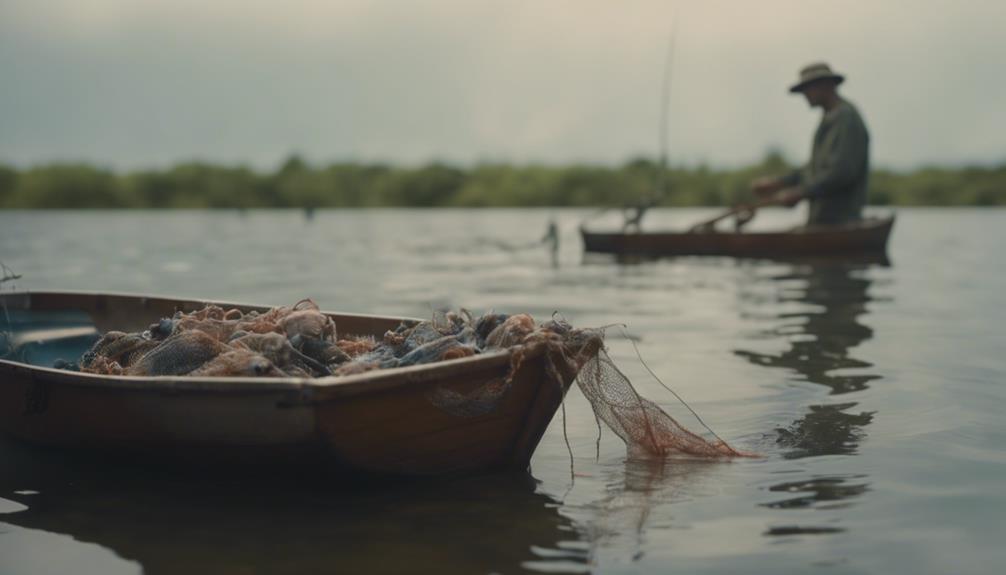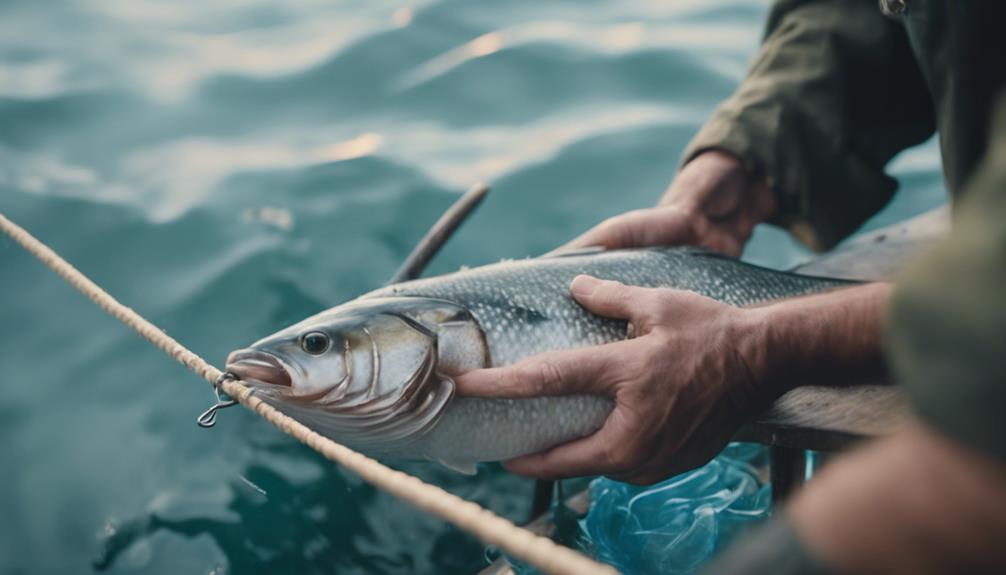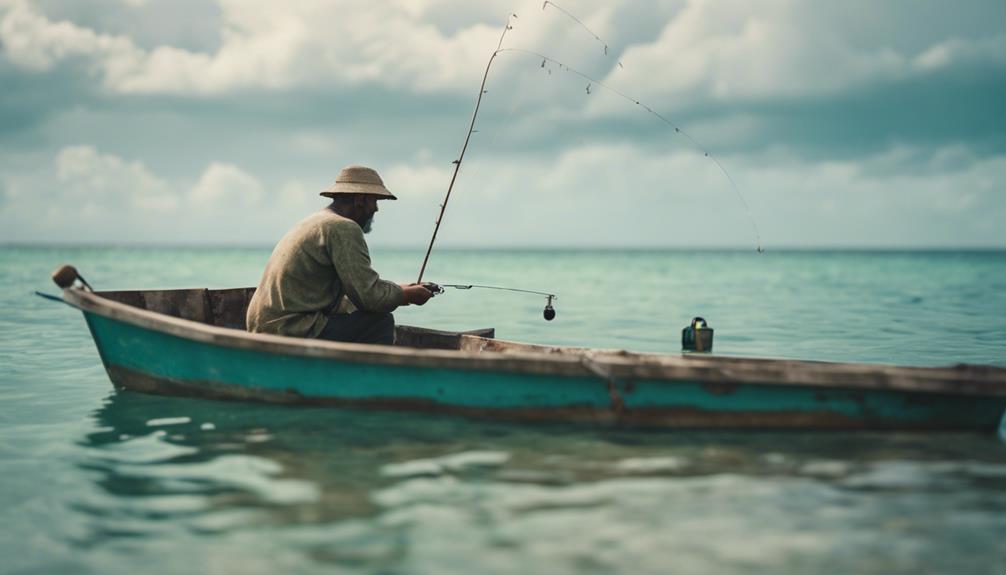So, you've been reeling in those fish, but is there a sneaky culprit tagging along in your catch?
Let's talk about how line fishing practices can help you slash bycatch numbers and why it's more essential than you might think.
From simple tweaks to innovative methods, this guide might just be the missing piece to your fishing puzzle.
Stay tuned to uncover the secrets of reducing bycatch and making a positive impact on our marine ecosystems.
Key Takeaways
- Hand lining reduces bycatch by targeting specific species effectively.
- By using hand lining, fishermen can minimize accidental capture of non-target marine animals.
- Sustainable hand lining practices promote conservation and reduce bycatch mortality rates.
- Implementing best practices like proper bait selection enhances hand lining efficiency for bycatch reduction.
Overview of Hand Lining Technique

If you're looking to learn about the basics of hand lining, this overview will give you a clear understanding of this traditional and eco-friendly fishing technique. Hand lining is a traditional fishing method where a single fishing line with a baited hook is used, commonly found in small-scale and artisanal fisheries.
This approach is environmentally friendly, as it minimizes impact on marine ecosystems and reduces bycatch compared to other fishing methods. By utilizing hand lining, fishermen can target specific fish species, enabling selective fishing practices and decreasing unintentional catch of non-targeted marine animals.
This method isn't only cost-effective but also requires skill and technique to attract and catch fish without the need for complex gear or equipment. Hand lining is a sustainable fishing method adaptable to various environments, whether on boats, piers, or shorelines.
Benefits of Hand Lining for Bycatch Reduction

From the overview of hand lining, the benefits of this traditional fishing technique for reducing bycatch are significant in promoting sustainable fishing practices and marine conservation efforts. Hand lining allows fishermen to target specific species, minimizing accidental capture of marine animals. By reducing bycatch mortality rates, hand lining contributes to sustainable practices and protects vulnerable species from incidental capture.
This low-impact method gives fishermen better control over their catch, decreasing the likelihood of bycatch compared to other fishing techniques. Hand lining encourages selective fishing, where only desired species are caught, lessening the negative impact on marine ecosystems and biodiversity. Embracing hand lining can lead to a more responsible approach to fishing, benefiting both marine life and fisheries sustainability.
Best Practices for Hand Lining Efficiency

To enhance hand lining efficiency, prioritize proper bait selection to attract target species effectively. When hand lining, consider the following tips for best results:
- Choose the Right Bait: Select bait that's specific to the species you're targeting, increasing the chances of a successful catch while minimizing unintended bycatch.
- Adjust Depth and Speed: Experiment with different depths and speeds to find the most productive combination for the targeted species, guaranteeing a more efficient fishing process.
- Regularly Check and Maintain Gear: Inspect your hand lining equipment regularly to make sure it's in good working condition, preventing any disruptions in your fishing efforts. Properly maintained gear contributes to sustainable fishing practices and helps protect marine ecosystems.
Implementing Sustainable Hand Lining Methods

When implementing sustainable hand lining methods, prioritize selecting the appropriate gear for the targeted species to minimize environmental impact and promote responsible fishing practices.
Hand lining is an eco-friendly and cost-effective way of fishing that allows you to target specific species precisely. This method gives you control over the fishing process, making it easier to release any unwanted catch.
By using sustainable hand lining techniques, you contribute to marine conservation efforts and help protect vulnerable species from the harmful effects of bycatch.
Future Innovations in Hand Lining Conservation

For exploring future innovations in hand lining conservation, consider how advancements in gear technology can further enhance sustainability efforts in fishing practices.
- Improved Material: Developing eco-friendly materials for hand lines can reduce environmental impact while maintaining durability.
- Smart Hooks: Implementing technology in hooks that can distinguish between target and non-target species can greatly decrease bycatch.
- GPS Integration: Incorporating GPS systems in hand lining gear can help fishermen track and avoid sensitive marine areas, contributing to conservation efforts.
These innovations aim to uphold the tradition of hand lining while advancing sustainable practices, reducing the impact on marine species and ecosystems. Embracing such advancements can lead to a more efficient and environmentally conscious approach to commercial fishing.
Conclusion
So, remember to use hand lining techniques to help reduce bycatch when you're out fishing. Stick to best practices for efficiency and sustainability, and keep an eye out for future innovations in conservation.
By working together and taking action, we can make a real difference in protecting marine species and ecosystems. Happy fishing and good luck cutting down on bycatch!
👨👩👧👦 Dwight’s a married dad of 4 who loves to cast a line 🎣 into both fresh and salt waters. His heart belongs to his family and the sea. 🌊 #FamilyMan #FishingLife #DadOf4 🐟✨

